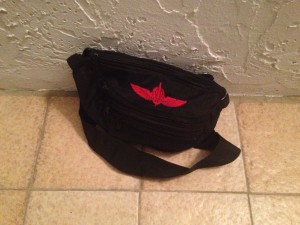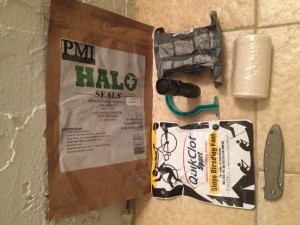Personal Trauma Kit for the Operator
Over the last decade I have found myself in various situations in the field as an operator and as an instructor. Typically one becomes an expert in the following fashion: Initial personal qualifications give one the foundation in order to be eligible for education and training, with that specific knowledge comes the opportunity to gain the experience. Only through experience in the field dose one develop into an expert. Of course there are experts on various levels and of niche subject matters. In this case I would like to discuss the development of a trauma first aid kit and the associated training that goes along with it.
 First let me say that the best kit you can buy is the one you design your self, with exactly what you need. Buying one at Wal-Mart or the like will defiantly not suit the purpose of a mission built kit to deal with ailments associated with combat. We must be able to aggressively control bleeding, not treat bee stings and scrapes. Typical injuries the warrior will have in combat are gun shot wounds (GSW), to various sections of the body, multiple stab and slash wounds, loss of limb due to an explosion or similar. Again we must stop bleeding not to focus on performing CPR on an otherwise health individual. A trauma kit must be mission specific.
First let me say that the best kit you can buy is the one you design your self, with exactly what you need. Buying one at Wal-Mart or the like will defiantly not suit the purpose of a mission built kit to deal with ailments associated with combat. We must be able to aggressively control bleeding, not treat bee stings and scrapes. Typical injuries the warrior will have in combat are gun shot wounds (GSW), to various sections of the body, multiple stab and slash wounds, loss of limb due to an explosion or similar. Again we must stop bleeding not to focus on performing CPR on an otherwise health individual. A trauma kit must be mission specific.
After spending a considerable amount of time with the Israeli military in an elite outfit, later as a body guard in hostile environments and as a law enforcement officer I have had many training courses and even served as a medic on my team in the IDF. In reality I was able to treat several GSW, and various other evulsions. I have been trained in the IDF Elite Unit Combat /Medic Course, US DOT EMT program, TCCC with the USCG and I am certified as a Red Cross and AHA Instructor. Some of the training courses were more relevant and more realistic then others, but anyone who is going into the field for combat operations must master the following skills. Each skill must be mastered for both for indications and applications:
- Tourniquet Application (SWATT, CAT, SOFT)
- Heamcon
- Quickclot
- Oral and nasal airway
- Pressure dressing
- Asherman chest seal
- IV set preparation
- IV fluid administration
- AMBO bagging
- Intubation Assistance for a Paramedic etc
- Intravenous drug preparation for the Paramedic etc
- Buddy carries and various typs of extractions
- 8 part and 4 part stretcher use.
There must be skills training for the following traumas:
- GSW
- Stab wound
- Crush
- Avulsion
- Penetrating trauma
- Burn
- Loss of limb
- Tactical evacuation
- Care under fire
- Schematics of care under fire
- etc
One of the best training courses the individual operator can attend is the TCCC course or Tactical Combat Casualty Care. This three-day seminar offers real life training in simulated combat situations (with associated stress) complete with buddy carries and extractions. This is a course that features live tissue and gives you the practical skills to save yourself or someone else in combat.

Personally I have a trauma kit that I take with me every time I teach a course, a separate kit in my car, on in my house and one I keep with me when I travel. On my person I will carry a pouch with the following items:
- Glock 17C 9mm Pistol
- 2 Magazines
- An Asherman chest seal
- Israeli Bandage
- Small quality Knife
- Small quality flashlight
- Size three airway
- Ace bandage with Velcro closure
- Flex cuffs X2
- Communication
- ID
- Cash
- Lock picks
Mr. Machine is a veteran of the Israeli counter-terrorism unit Duvedevan. He is author of Israeli Security Concepts (CreateSpace, 2010) and provides security consultation and training (www.counterterrorwarfare.com).


5 Comments
Pingbacks